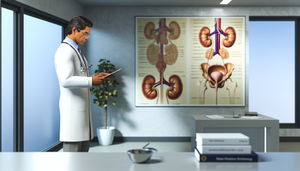
Acute Lymphoblastic Leukemia: Prognosis, Risk Factors, and Survival Rates in Pediatric and Adult Patients
Explore how advancements in personalized therapies are enhancing survival rates in acute lymphoblastic leukemia.
Read more
Chronic Myeloid Leukemia: Prognosis Evaluation and Life Expectancy Factors for Improved CML Survival
Discover how tyrosine kinase inhibitors have transformed the prognosis of chronic myeloid leukemia, bringing patients' life expectancy closer to normalcy.
Read more
Acute Myeloid Leukemia: Prognosis, Survival, and Key Cytogenetic and Molecular Factors Affecting AML Life Expectancy
The integration of cytogenetic and molecular factors enhances risk stratification and personalizes treatments in AML.
Read more
Non-Hodgkin Lymphoma: Prognosis, Life Expectancy, and Survival Rates Across Subtypes
The prognosis and life expectancy in non-Hodgkin lymphoma depend on the specific subtype and prognostic factors.
Read more
Hodgkin Lymphoma: Prognosis, Risk Factors, and Life Expectancy in Hematology-Oncology
Advancements in treatment have significantly improved the prognosis and survival rates of Hodgkin lymphoma.
Read more
Prognostic Factors and Survival Rates in Nasal Cavity Cancer: Insights on Sinus Tumors and Life Expectancy
Explore how endoscopic techniques and advanced therapies enhance survival in sinus cancer.
Read more
Nasopharyngeal Cancer: Prognostic Factors and Survival Projections for Improved Life Expectancy
Discover how molecular biomarkers and advanced techniques enhance the prognosis of nasopharyngeal cancer.
Read more
Laryngeal Cancer: Prognosis, Life Expectancy, and Survival Factors for Head and Neck Tumors
Explore how early diagnosis and surgical intervention enhance survival rates in laryngeal cancer.
Read more
Pharyngeal Cancer: Prognosis, Survival Rates, and Key Prognostic Factors for Oropharyngeal Tumors
Discover how tumor stage and HPV status impact survival in pharyngeal cancer.
Read more
Oral Cancer: Prognosis, Life Expectancy, and Survival Factors in Multidisciplinary Treatment
A multidisciplinary approach and biomarkers such as miR-21 and miR-31 enhance survival in oral cancer.
Read more
Vulvar Cancer: Prognosis, Survival Rates, and Key Factors for Management
Explore how early diagnosis and personalized treatment enhance survival in vulvar cancer.
Read more
Vaginal Cancer: Prognosis, Life Expectancy, and Key Survival Factors for Gynecological Specialists
Discover how prognostic factors like HPV and p16 enhance survival in vaginal cancer.
Read more
Endometrial Cancer: Prognosis, Survival Rates, and Key Prognostic Factors in Clinical Practice
Molecular classification and personalized surgery enhance prognosis and survival in endometrial cancer.
Read more
Cervical Cancer Prognosis and Life Expectancy: Key Insights for Gynecologists on Survival and Prognostic Factors
Discover how advancements in predictive models and treatments are enhancing survival rates in cervical cancer.
Read more
Ovarian Cancer: Prognosis, Life Expectancy, and Key Survival Factors in Gynecological Cancer
Discover how stage, histological type, and biomarkers influence ovarian cancer survival.
Read more
Penile Cancer: Prognostic Factors and Life Expectancy in Clinical Management
Early detection and centralized treatment significantly improve survival in penile cancer.
Read more
Testicular Cancer: Prognosis, Survival Rates, and Key Factors Influencing Life Expectancy
Testicular cancer has a favorable prognosis with high survival rates, even in advanced stages.
Read more
Urothelial Carcinoma: Prognostic Guidelines and Survival Insights for Medical Practice
Discover how biomarkers and histological variants influence the prognosis of urothelial carcinoma.
Read more
Renal Cell Carcinoma: Prognosis, Life Expectancy, and Survival Factors in Kidney Cancer
Discover how advancements in predictive models and technologies are enhancing survival rates in renal cancer.
Read more
Bladder Cancer Prognosis and Survival: Staging and Risk Factors Impacting Life Expectancy
Discover how bladder cancer staging and risk factors impact survival rates.
Read more